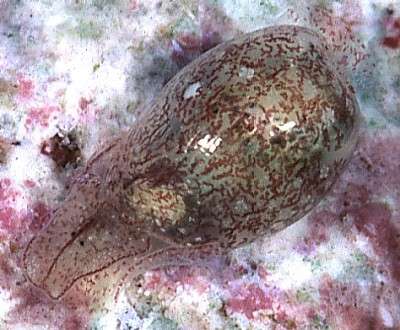
haminoeid - genus unknown 2.
Order: CEPHALASPIDEA
Superfamily: HAMINOEOIDEA
PHOTO
Kerama Is, near Okinawa, Japan. 4m depth. shell length 6mm. PHOTO: Atsushi Ono.
See messages below. Carlson & Hoff consider it to be almost certainly an unnamed species belonging to neither the 'atyiid' nor 'haminoeid' groups.
Authorship detailsRudman, W.B., 2000 (February 17) haminoeid - genus unknown 2. [In] Sea Slug Forum. Australian Museum, Sydney. Available from http://www.seaslugforum.net/find/haminoid2
Related messages
Re: Haminoeid sp. 2 from Heron Island
April 25, 2005
From: Clay Carlson & Patty Jo Hoff
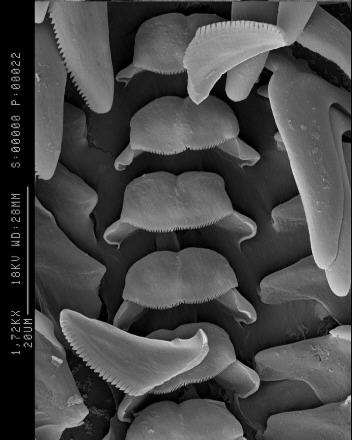
Bill,
Here is something to go with Julie's animal.[message #13534 ] -- sorry about the 'piecemeal' approach. Notice that only the 1st lateral on the left hand side is denticulate (as well as the rachidian); something we have found to be relatively common. This is C.7, one of our 'otherids'. The radula came from a 5.5mm specimen; Guam, Bile Bay, 2m; 25 October 1990. Photographer: Geoff Avern.
Clay & Patty Jo
ccarlson@kuentos.guam.net
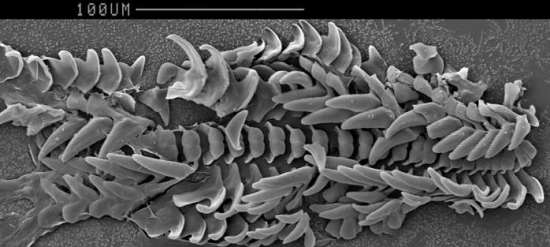
Thanks Clay & Patty Jo,
Strange about the denticulation only on the left side. Do the 'otherids' have gizzard plates?
Best wishes,
Bill Rudman
Rudman, W.B., 2005 (Apr 25). Comment on Re: Haminoeid sp. 2 from Heron Island by Clay Carlson & Patty Jo Hoff. [Message in] Sea Slug Forum. Australian Museum, Sydney. Available from http://www.seaslugforum.net/find/13630
Haminoeid sp. 2 from Heron Island
April 23, 2005
From: Julie Marshall
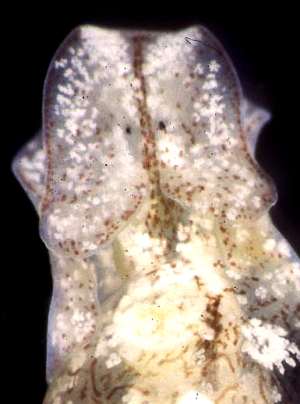
Dear Bill,
Attached is another Haminoea from the reef flat at Heron Island. It was found on Halimeda and measured 5 mm.
The animal was very transparent. The head and parapodia were outlined with brownish-red dots and there was a double line of these dots along the median line. The mantle within the shell had a brownish-red pattern often surrounding cream patches. Opaque white dots and patches were present on the transparent tail, the parapodia and the head.
Locality: Heron Island, Great Barrier Reef, Queensland, Australia. Pacific Ocean. Depth: Intertidal. Length: 5 mm. 13 March 2005. Intertidal. Photographer: Julie Marshall
Best wishes,
Julie Marshall
juliemarshall@netspace.net.au
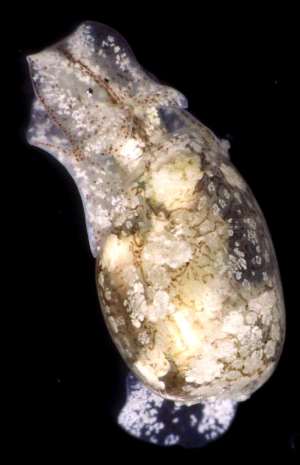
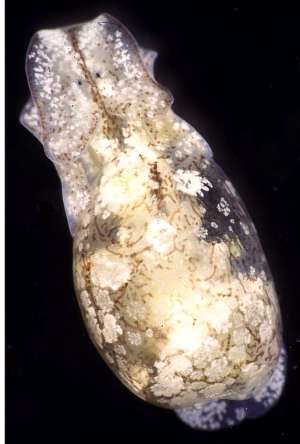
Dear Julie,
If species of Haminoea had been described from the living animals rather than from the dead shells, then this would be instantly recognisable from the border of brown spots around the edge of the head shield.
I am pretty sure this is the species called haminoeid sp. 2. on the Forum, which Clay Carlson and Patty-Jo Hoff have looked at in Guam, and has been reported on the Forum from Kerama Is., Japan, suggesting a wide distribution.
Best wishes,
Bill Rudman
Re: unidentified cephalaspid from Kerama Is
February 18, 2000
From: C.Carlson & P.J.Hoff
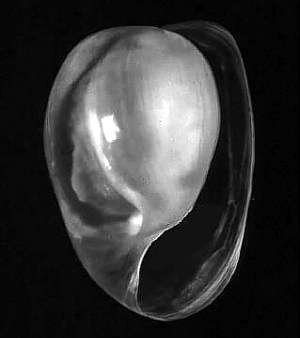
Bill,
Atsushi must be getting into the Lyngbya. We find both the earlier Ventomnestia villica and this unknown species in that type of environment. We doubt if this animal or a second very similar form have been described. The shells are extremely fragile. They are easily broken with a fine jet of water from a syringe. We have not done any dissecting on this particular form, but do have the attached shell as well as data on the egg mass and
development times.
We have three gross classifications: atyid, haminoeid, otherid -- this present animal is in our 'otherid' class.
Shell, 2.5 x 1.9mm; Guam, Bile Bay, 17m; 1 July 1998. [c132_2a C.132]
Clay & Patty Jo
Guam
clay.carlson@kuentos.guam.net
Carlson, C. & Hoff, P.J., 2000 (Feb 18) Re: unidentified cephalaspid from Kerama Is. [Message in] Sea Slug Forum. Australian Museum, Sydney. Available from http://www.seaslugforum.net/find/1911Dear Clay & Patty Jo,
I am sure this is not the only 'otherid' you have. Thanks for letting us know.
Bill Rudman.
Another bubble shell from Kerama Island
February 3, 2000
From: Atsushi Ono

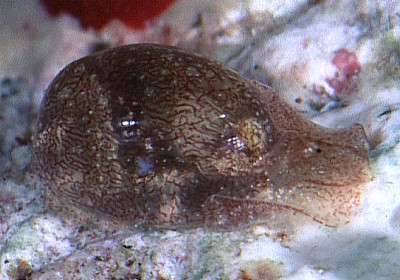
Dear Bill,
Here is another CEPHALASPIDEA species from Kerama Is, near Okinawa, Japan. 4m depth. It was on a rope covered with algae and sponge.
Both photos are of the same individual, shell length 6mm. I have seen several individuals of this species here.
Is this an Atys or Haminoea species?
Could you help me to identify these species?
Sincerely,
Atsushi Ono
ononini@cosmos.ne.j
Ono, A., 2000 (Feb 3) Another bubble shell from Kerama Island. [Message in] Sea Slug Forum. Australian Museum, Sydney. Available from http://www.seaslugforum.net/find/1822Dear Atsushi,
I am sorry again to be unable to help you with a name for this animal. From the shape of the body and shell it is possibly a species of Haminoea.
We have a major problem in identifying cephalaspids (bubble-shells) because in earlier times many species were described and named from the empty shell alone and so we don't know what the animal looks like. Another problem is that often two or more species can have almost identically shaped shells. Sometimes even species from quite different families can have identically shaped shells. Therefore in case of some named species the shells have been placed in the wrong genus or even family.
So when we now find a living animal we need to remove its shell and try and find a named shell that matches it, even if it is clearly in the wronf family. If we find two or three named shells which match it in shape, what do we do? Clay Carlson has for many years been investigating cephalaspid animals and trying to identify them with named shells. It is a very slow and exhausting task.
Many early European and American explorers took specimens from Japan, Australia, and much of the tropical world, and deposited them in museums in Europe and America. Often the published descriptions of these specimens were poor, with no illustrations or very inadequate illustrations. The only way to resolve many of these puzzles is to visit museums throughout Europe in the hope of finding the right shell. It is extremely expensive and often frustrating, but necessary for malacologists from outside Europe to travel around European museums trying to find these specimens so they can make sense of their local faunas. However, it is very hard to convince governments that it is important to fund trips to Europe to look for lost shells which you don't even know exist.
In Japan there have been a number of very productive workers who have studied cephalaspids and published detailed descriptions of their shells. However you would need to look at the shells of your animals before a comparison could be made.
Bill Rudman.
